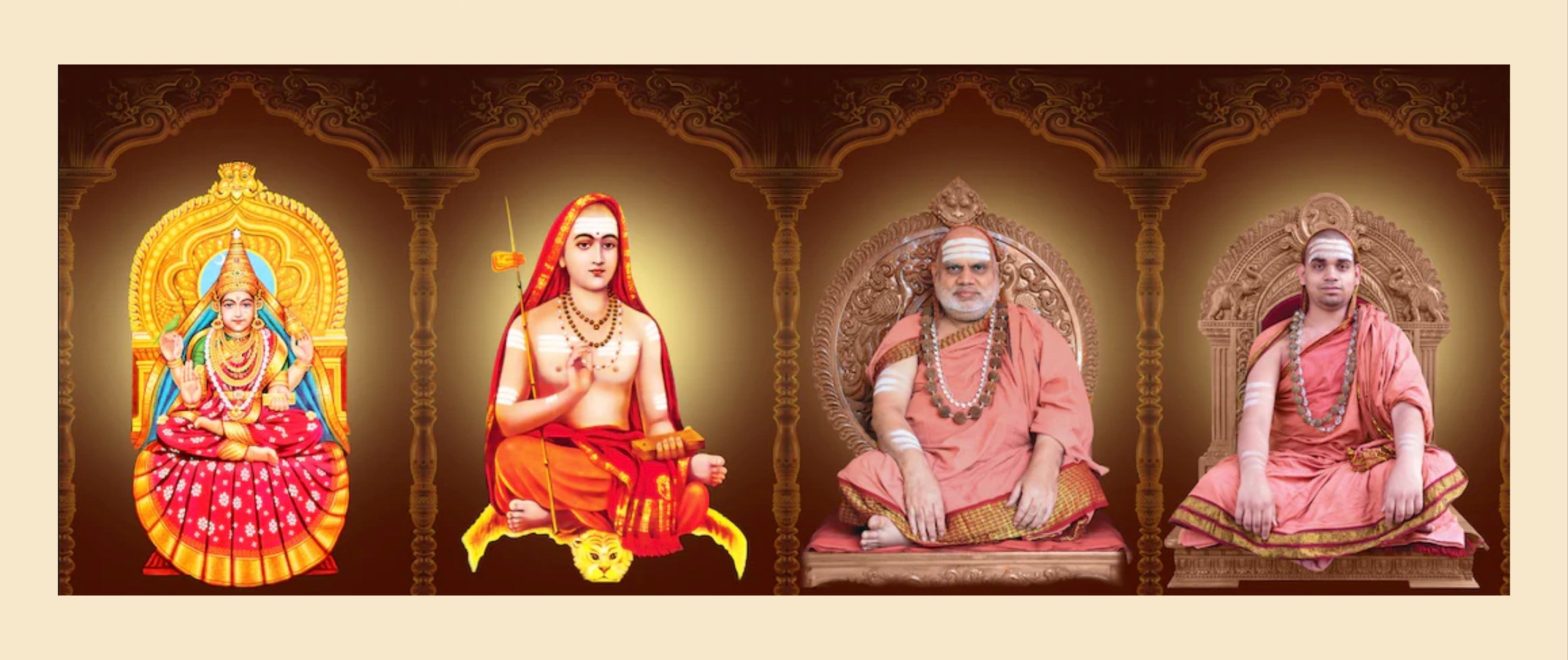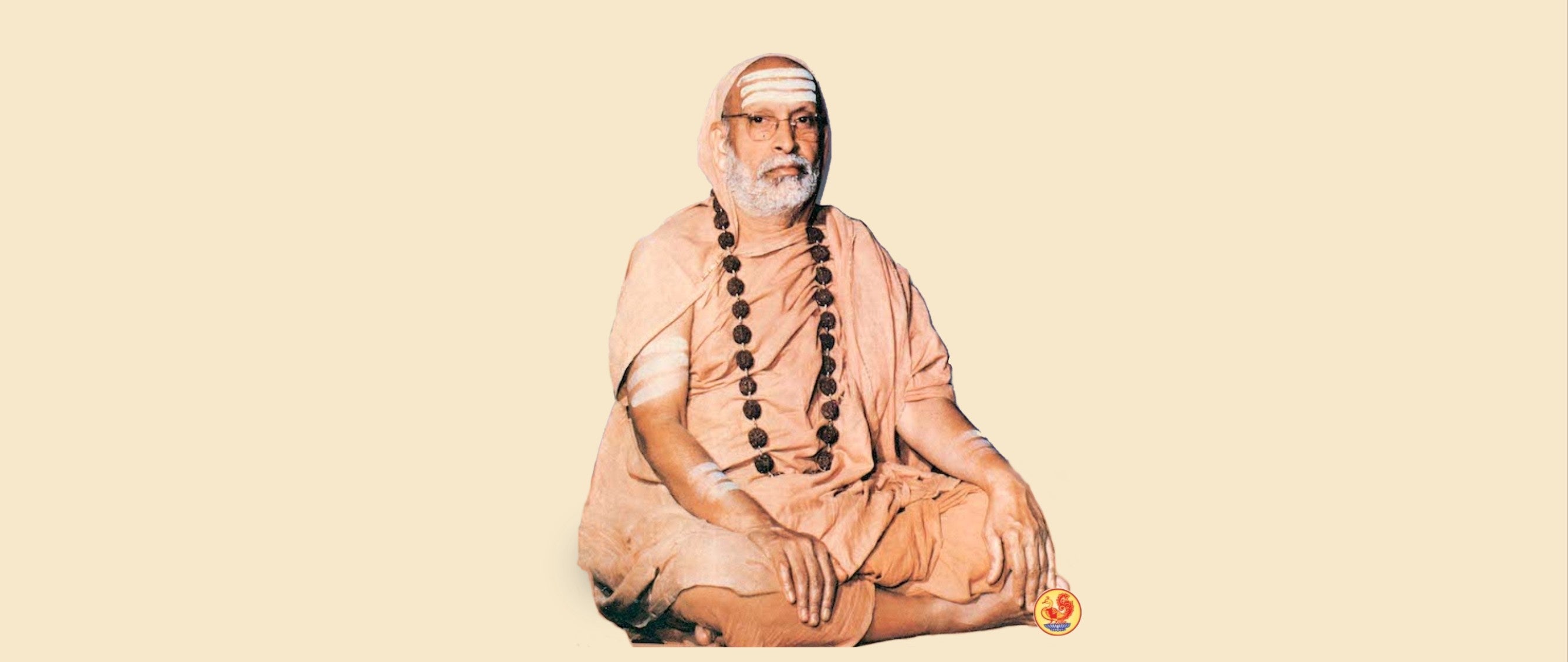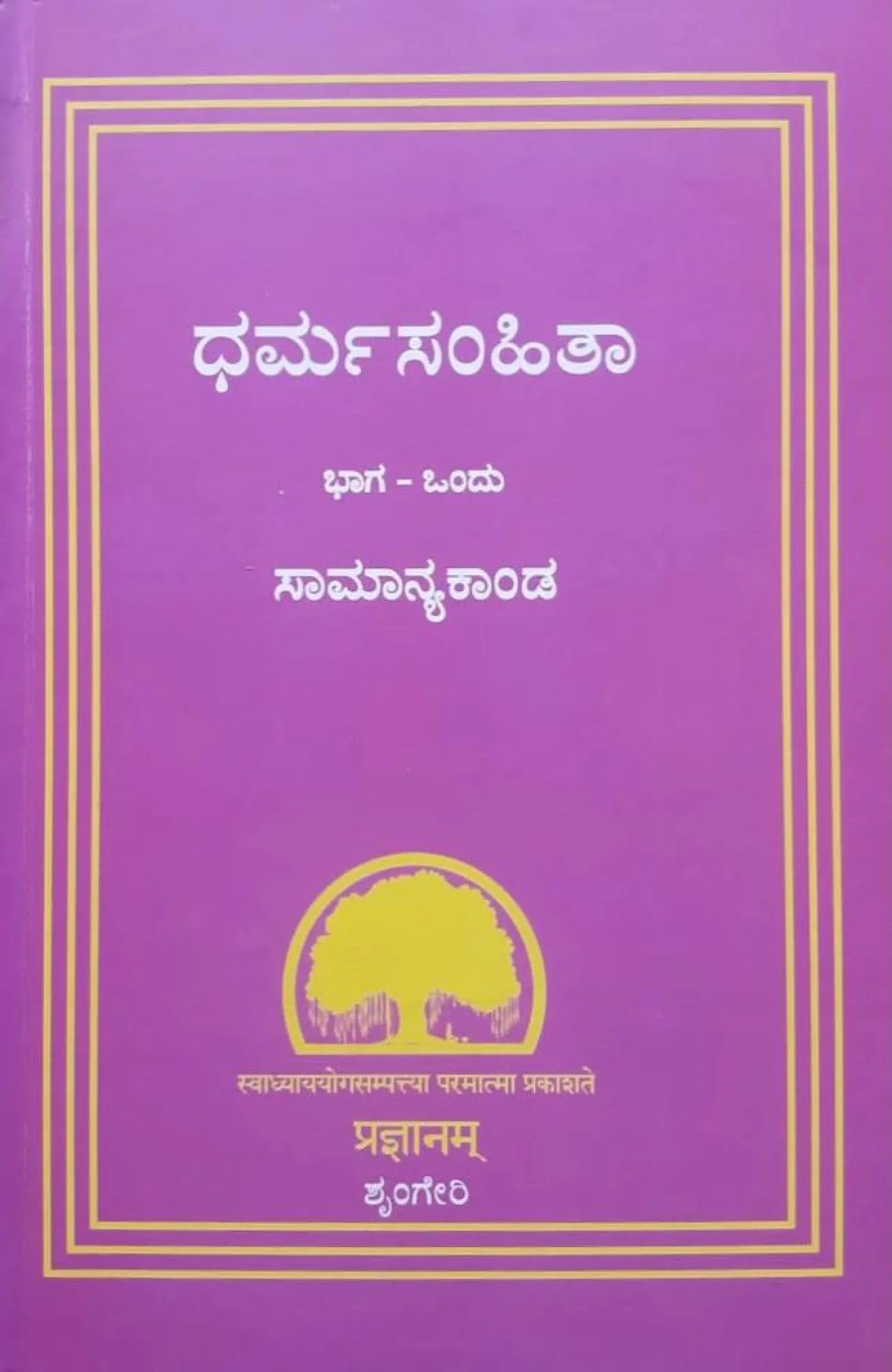Sringeri Guru Parampara
आचार्य-परम्परा ācārya-paramparā
Guru: Sri Nrisimha Bharati VIII
Guru: Sri Sacchidananda Shivabhinava Nrisimha Bharati Mahaswamiji
Guru: Sri Chandrashekhara Bharati Mahaswamiji
Guru: Sri Bharati Tirtha Mahaswamiji
List of revered gurus of Sringeri Guru Parampara:
The holy Guru-Shishya Parampara, avichchinna (unbroken) Guruparampara of Dakshinamnaya Sringeri Sharada Peetham is given below.

|
Sri Gaudapada Acharya |
||
|
Sri Govinda Bhagavatpada |
||
|
# |
शृङ्गेरी-गुरु-परम्परा śṛṅgerī-guru-paramparā |
Period |
|
1. |
Sri Shankara Bhagavatpada |
820 (videha-mukti) |
|
2. |
Sri Sureshwaracharya |
820 – 834 |
|
3. |
Sri Nityabodaghana |
834-848 |
|
4. |
Sri Jnanaghana |
848 – 910 |
|
5. |
Sri Jnanottama |
910 – 954 |
|
6. |
Sri Jnanagiri |
954 – 1038 |
|
7. |
Sri Simhagiri |
1038 – 1098 |
|
8. |
Sri Ishwara Tirtha |
1098 – 1146 |
|
9. |
Sri Nrisimha Tirtha |
1146 – 1229 |
|
10. |
Sri Vidya Tirtha |
1229 – 1333 |
|
11. |
Sri Bharati Tirtha |
1333 – 1380 |
|
12. |
Sri Vidyaranya |
1380 – 1386 |
|
13. |
Sri Chandrasekhara Bharati I |
1386 – 1389 |
|
14. |
Sri Nrisimha Bharati I |
1389 – 1408 |
|
15. |
Sri Puroshottama Bharati I |
1408 – 1448 |
|
16. |
Sri Shankara Bharati |
1448 – 1455 |
|
17. |
Sri Chandrasekhara Bharati II |
1455 – 1464 |
|
18. |
Sri Nrisimha Bharati II |
1464 – 1479 |
|
19. |
Sri Puroshottama Bharati II |
1479 – 1517 |
|
20. |
Sri Ramachandra Bharati |
1517 – 1560 |
|
21. |
Sri Nrisimha Bharati III |
1560 – 1573 |
|
22. |
Sri Nrisimha Bharati IV |
1573 – 1576 |
|
23. |
Sri Nrisimha Bharati V |
1576 – 1600 |
|
24. |
Sri Abhinava Nrisimha Bharati |
1600 – 1623 |
|
25. |
Sri Sacchidananda Bharati I |
1623 – 1663 |
|
26. |
Sri Nrisimha Bharati VI |
1663 – 1706 |
|
27. |
Sri Sacchidananda Bharati II |
1706 – 1741 |
|
28. |
Sri Abhinava Sacchidananda Bharati I |
1741 – 1767 |
|
29. |
Sri Nrisimha Bharati VII |
1767 – 1770 |
|
30. |
Sri Sacchidananda Bharati III |
1770 – 1814 |
|
31. |
Sri Abhinava Sacchidananda Bharati II |
1814 – 1817 |
|
32. |
Sri Nrisimha Bharati VIII |
1817 – 1879 |
|
33. |
Sri Sacchidananda Shivabhinava Nrisimha Bharati |
1879 – 1912 |
|
34. |
Sri Chandrasekhara Bharati III |
1912 – 1954 |
|
35. |
Sri Abhinava Vidyatirtha Mahaswamiji |
1954 – 1989 |
|
36. |
Sri Bharati Tirtha Mahaswamiji |
1989 – Present |
|
37. |
Sri Vidhushekhara Bharati Mahaswamiji |
Successor-Designate |
Sri Nrisimha Bharati VIII

Life and spiritual journey
- Early Spiritual Inclination: Sri Nrisimha Bharati, born in 1798, displayed a profound inclination toward spirituality from a young age, journeying to Kasi to study the Sastras.
- Assuming Peetham Leadership: After becoming the head of the Peetham, he dedicated himself to mastering various branches of learning and the administration of the Mutt.
- Austerity and Discipline: Known for his extreme discipline, he conquered hunger and sleep, subsisting on minimal food and dedicating most of his day to meditation and puja.
- Commissioner Bowring's Visit: In 1858, Commissioner Bowring visited incognito and was deeply moved by the Acharya’s devotion during a midnight puja.
- Firm Resolve and Tender Heart: Despite his stern exterior from constant meditation on God Narasimha, he had a tender heart that easily melted at the sight of distress.
- Rameshwaram Pilgrimage: In 1838, he instructed his attendants to draw water from Koti-tirtha for his bath, but faced opposition from the temple staff, leading him to sanctify another well, Sarva-tirtha.
- Restoration of Koti-tirtha: In 1873, he purified Koti-tirtha with sanctified water, restoring its use and significance for pilgrims.
- Invitation by Maharaja of Mysore: In 1822, Maharaja Krishna Raja Wodeyar III invited the Acharya to Mysore, granting several privileges to the Mutt.
- Northern Pilgrimage: The Acharya’s northern pilgrimage in 1842 was marked by respect and devotion from rulers and devotees.
- Meeting with Prominent Rulers: During his travels, he received support and contributions from rulers like Jayaji Rao Sinde of Gwalior and Shaji Raja Bhosle of Akalkot.
- Second Visit to Mysore: In 1854, he returned to Mysore, initiating the Maharaja into the study of Shiva Gita.
- Chaturmasya at Bhavnagar: In 1855, he performed Chaturmasya at Bhavnagar, followed by a three-year visit to Hyderabad, acknowledged by the Nizam’s administration.
- Nizam's Proclamations: The Nizam’s prime minister issued proclamations recognizing the Acharya’s spiritual significance and ordered officials to assist his tour.
- Return to Sringeri: At sixty, after returning to Sringeri, he decided to nominate his successor.
- Nomination of Successor: He chose young Shivaswami, who was ordained as Sri Sacchidananda Shiva Abhinava Nrisimha Bharati Swami.
- Extended Tour with Successor: The Jagadguru and his successor toured various districts for twelve years, receiving governmental support and public admiration.
- Bowring's Recognition: Commissioner Bowring acknowledged the Guru’s immense influence and spiritual authority over southern India’s Hindus and leading Marathas.
- Training His Successor: During these twelve years, he meticulously trained his successor in all aspects of spiritual leadership.
- Final Return to Sringeri: The Jagadguru returned to Sringeri in 1877 after completing his extensive tours and training his successor.
- Entering Mahasamadhi: In 1879, Sri Nrisimha Bharati entered Mahasamadhi, leaving behind a legacy of profound spirituality and devotion.
Below are some notable works attributed to him:
- Bhakti Sudha Tarangini:
- A collection of hymns composed by Sri Nrisimha Bharati VIII, often sung during temple visits and other religious occasions. This anthology reflects his deep devotion and spiritual insight.
- Vedanta Prakriya Pratyabhijna:
- This work elucidates the principles of Vedanta philosophy, making the complex ideas accessible to a broader audience. It is revered for its clarity and depth in explaining Advaita Vedanta.
- Tattva Prakashika:
- A detailed commentary on the essential truths of Vedanta, this text is valued for its philosophical rigor and comprehensive treatment of key concepts in non-dualism.
- Nrisimha Stuti:
- A devotional hymn dedicated to Lord Narasimha, showcasing the author's profound reverence and the deity's significance in Vedantic thought.
- Vedanta Saravali:
- A concise yet profound exploration of Vedantic teachings, designed to guide practitioners on their spiritual journey.
These works collectively reflect Sri Nrisimha Bharati VIII's dedication to spreading the wisdom of Vedanta and his role in preserving and enhancing the spiritual heritage of Sringeri Sharada Peetham. His contributions continue to inspire and guide spiritual seekers and scholars in the study and practice of Vedanta philosophy.
Sri Sacchidananda Shivabhinava Nrisimha Bharati Mahaswamiji

Life and spiritual journey
- Early Life and Selection: Sri Sacchidananda Shivabhinava Nrisimha Bharati Mahaswamiji, originally named Shivaswami, was born with extraordinary spiritual potential.
- Initiation: In 1866, Sri Nrisimha Bharati Swami ordained Shivaswami under the Diksha name of Sri Sacchidananda Sihvabhinava Nrisimha Bharati at the age of eight.
- Recognition of Successor: The Jagadguru Sri Nrisimha Bharati VIII, during his contemplation, felt the need to nominate a successor. After an eight-year search, he found Shivaswami's horoscope satisfactory.
- Spiritual Training: Young Shivaswami exhibited spiritual potential early on, even murmuring "Sarvoham, Sarvoham" in his sleep during his initiation.
- Early Duties: From 1879, he adorned the Vyakhyana Simhasana, Throne of Transcendental Wisdom, taking over the responsibilities of the Peetha.
- First Northern Tour: In February 1886, he commenced his first tour to the north, reaching Kolhapur and returning to Sringeri in 1890 after a four-year digvijaya.
- Southern Tour: In 1891, he accepted an invitation from Maharaja Chamaraja Wodeyar and toured southern regions, including Srirangapatnam, Nanjangud, and Coorg.
- Promotion of Vedic Studies: He set up Pathasalas (schools) for Vedas and Sastras in Bangalore and other places, providing support for their growth.
- Second Tour to the North: In 1894-1895, he toured various regions, influencing many and establishing educational institutions.
- Publication of Shankara's Works: He was responsible for the publication of Adi Shankara's collected works under the title Shaankara Granthavali.
- Kaladi Establishment: He established Kaladi as the birthplace of Shankara, identifying the sites and consecrating temples for Sri Shankara and Sri Sharadamba.
- Institution of Shankara Jayanti: He started the celebration of Shankara Jayanthi festival in India, which has since become a significant annual event.
- Spiritual Influence: Many skeptics were reformed into believers by his teachings.
- Third Tour to the South: In 1895, he visited several towns including Madurai, Ramanathapuram, and Rameshwaram, influencing local practices and traditions.
- Institutional Developments: He established the Sadvidya Sanjivini Patashala for studies in Vedas and Sastras and taught Vedanta to advanced students.
- Inspiration to Successor: His Holiness Sri Chandrasekhara Bharati, the 34th pontiff of Sringeri Sharada Peetham, was his devotee and successor.
- Fourth Tour to Kaladi: In February 1907, he commenced his tour to Kaladi, leading to the consecration of shrines for Sri Shankara and Sri Sharada on February 21, 1910.
- Establishment of Shrines: The consecration of the shrines symbolized the re-descent of Sri Shankara on the earth.
- Final Years: In his later years, he sought a quiet life of contemplation in Narasimha Vana but continued his spiritual mission, including the construction of a new temple for Sri Sharada in Sringeri.
- Passing: On March 20, 1912, the great Acharya attained Videhamukthi, and his mortal remains were interred in Narasimha Vana, with a linga installed over the samadhi.
Works by Sri Sacchidananda Shivabhinava Nrisimha Bharati Mahaswamiji
- Shaankara Granthavali: A collection of Adi Shankara's works published under his initiative.
- Bhaktisudhatarangini: An anthology of hymns sung by the Jagadguru on different occasions.
Sri Chandrashekhara Bharati Mahaswamiji

Life and spiritual journey
- Early Devotion: Demonstrated deep enthusiasm for dharma and devotion to guru and God from a young age.
- Guidance by Guru: Educated by Sri Sachchidananda Sivabhinava Narasimha Bharati, achieving mastery in Sastras.
- Head of Sringeri Sharada Peetham: Became the head of Sringeri Sharada Peetham at age 20 and efficiently managed its affairs.
- Simple and Humble Life: Lived a simple life without worldly desires despite his prestigious position.
- Transformative Power: Had the ability to convert non-believers into believers with a mere glance.
- High Dispassion:Attained great dispassion and nominated his successor at the age of 40 to focus on tapas.
- Extended Puja on Narasimha Jayanti: Extended the hours of puja on Narasimha Jayanti from noon to dusk, exemplifying his devotion.
- Scholarly Achievements: Mastered Vedanta and other Shastras, displaying profound scholarship.
- Renovation of Shrines: Completed the renovation of the Sri Sharada temple and built a shrine over his guru's Samadhi.
- Withdrawal for Tapasya: Withdrew into solitude for intense tapasya, coming out occasionally to teach deserving disciples.
- Nomination of Successor: Designated Sri Abhinava Vidya Tirtha Swami as his successor in 1931.
- Limited Public Interaction: Seldom received disciples while in retirement, but a mere smile or nod from him was deeply enlightening.
- Videha Mukti: Achieved videha mukti by entering the Tunga river in 1954, with his body found in a meditative posture.
- First South India Tour: Undertook a tour of South India in 1924, visiting Mysore, Satyamangalam, Srirangam, and other regions.
- Chaturmasya Vows at Kunnakudi: Observed Chaturmasya vows at Kunnakudi during his first tour.
- Inauguration of Vedanta Course at Kaladi: Inaugurated a course in Vedanta at Kaladi and celebrated Shankara Jayanthi in 1927.
- Institution of Patashala at Nanjangud: Instituted a Patashala at Nanjangud during his first tour.
- Second Tour to Bangalore: Visited Bangalore in 1938, consecrating a shrine for Sri Sharada at the Bangalore Mutt premises.
- Sojourn in Kaladi: Stayed for ten months in Kaladi during his second tour, with support from the Maharaja of Travancore.
- Intense Tapasya and Seclusion: Gave himself up to intense tapasya and practical seclusion, focusing on spiritual practices.
Works by Sri Chandrashekhara Bharati Mahaswamiji
- Commentaries on Upanishads:
- Provided profound insights and elucidations on several Upanishads.
- Expositions on Vedanta:
- Authored detailed expositions on various Vedantic texts, enhancing understanding for scholars and devotees.
- Discourses on Dharma:
- Delivered discourses on dharma and its practical application in daily life.
- Spiritual Guidance:
- Wrote guidance on spiritual practices and the pursuit of moksha.
Sri Abhinava Vidyatirtha Mahaswamiji

Life and spiritual journey
- Born to Venkatalakshmi Ammal and Rama Sastry on November 13, 1917, he was named Srinivasa and showed piety and wisdom from a young age.
- As a child, he expressed a desire to renounce worldly life and see God, displaying exceptional qualities of wisdom and foresight.
- His Upanayana ceremony was performed at the Sharadamba temple, marking his entry into brahmacharya and scriptural studies.
- He was an obedient and conscientious student, catching the eye of the Jagadguru, Sri Chandrasekhara Bharati Mahaswamigal.
- In 1931, at the age of 13, he was initiated into the holy order of Sanyasa and named Abhinava Vidyatirtha by his Guru.
- His Guru foresaw his potential to equal great Yogis in spiritual attainment and initiated him into meditative contemplation.
- By age 15, he began deep contemplation of the Self, reaching Savikalpa Samadhi by 16 and Nirvikalpa Samadhi before 20.
- Formal lessons in Vedanta followed, confirming his spiritual experiences and understanding of scriptures.
- On September 26, 1954, Sri Chandrasekhara Bharati ended His mortal life, and on October 16, 1954, Sri Abhinava Vidyatirtha formally took over as the 35th Jagadguru Shankaracharya of the Sringeri Sharada Peetham.
- As an able administrator, he started improving the Math's infrastructure, including building a new guest house and renovating shrines.
- Despite financial challenges, he remained confident in the Math's spiritual mission, decentralizing power and ensuring efficient administration.
- He established branch Maths and consecrated many temples, spreading the Math's spiritual influence.
- His incredible memory and attention to detail reflected his deep spiritual focus and administrative capabilities.
- Starting in 1956, he embarked on his first tour, covering the four southern states over six years.
- In 1964, he started his second major tour, covering southern and northern India continuously for four years.
- He met the Shankaracharya of Dwaraka during his first all-India tour, a significant event hailed by press and public alike.
- In 1967, he celebrated Maha Shivaratri in Nepal at the request of King Mahendra, being the only Amnaya Pithadhipati to visit Nepal after Adi Shankara.
- In May 1979, he organized a historic summit meeting with the Jagadguru Shankaracharyas of Dwaraka, Badri, and Puri, showing unity among spiritual leaders.
- Throughout his tenure, he extensively traveled from Kanyakumari to Kashmir, blessing devotees and spreading spiritual teachings.
- His tireless work to elevate people's spiritual awareness, combined with his compassion, truthfulness, patience, fortitude, and righteousness, made him a revered spiritual leader.
Sri Abhinava Vidyatirtha Mahaswamiji was an influential spiritual leader and prolific author. Here are some of his notable works:
His works cover a wide range of topics including Vedanta, Yoga, spiritual discourses, and parables, reflecting his deep spiritual insights and teachings
Works by Sri Abhinava Vidyatirtha Mahaswamiji
- Sandhyavandanam: A guide to daily spiritual practices.
- Arivoottum Sirukathaigal: Short stories imparting wisdom.
- Meijnana Vilakkavuraigal: Explanations of true knowledge.
- Nenjil Niraintha Jagadguru: Teachings of the universal teacher.
- Yog, Sakshatkar Tatha Jeevanmukti: Discourses on Yoga and liberation.
- Shikshaprad Neetikathaen: Moral stories for spiritual education.
- Dukhon Se Paramanand Tak: Journey from sorrow to bliss.
- Scientific Evidence Vedantic Light: Bridging science and Vedanta.
- Divine Discourses: Collection of spiritual talks.
- Yoga, Enlightenment and Perfection: Insights on attaining spiritual perfection.
- Edifying Parables: Parables for moral and spiritual guidance.
- Exalting Elucidations: In-depth explanations of spiritual concepts.
- The Multifaceted Jivanmukta: Exploring the life of a liberated soul.
- Yoga, Sakshatkara Mattu Jivanmukti: Comprehensive treatise on Yoga and enlightenment.
Sri Bharati Tirtha Mahaswamiji

Life and spiritual journey
- Birth and Early Life (1951):
- Born into a family of Vedic scholars in 1951, named Sitarama Anjaneyalu.
- Childhood Devotion:
- Displayed deep devotion to Lord Shiva and great interest in Sanskrit and Vedic studies from a young age.
- Early Education:
- Studied Vedas and Sanskrit extensively, achieving command over language and religious texts by age nine.
- Encounter with Guru (1966):
- Met Sri Abhinava Vidyatirtha Mahaswamiji, the 35th Pontiff of Sringeri, in Ujjain and sought his tutelage at age 15.
- Study Under Guru:
- Studied various Vedic scriptures and commentaries under his Guru, becoming a distinguished scholar and disciple.
- Renunciation (1974):
- Renounced worldly life and embraced Sanyasa, receiving the name Bharati Tirtha and continuing under his Guru's guidance.
- Succession to Pontiff (1989):
- Ascended as the 36th Jagadguru Shankaracharya of Sringeri Sri Sharada Peetham after his Guru's Maha Samadhi.
- Inauguration of Vidyatirtha Sethu (1990):
- Completed and inaugurated the Vidyatirtha Sethu bridge, a project initiated by his Guru.
- Support for Vedic Scholars:
- Announced a lifetime allowance for deserving Vedic scholars, emphasizing the protection and sustenance of Vedic knowledge.
- Hospital Initiatives:
- Expanded and modernized the Sharada Dhanvantari Charitable Hospital, including Ayurveda and Homeopathy units.
- Development of Veda Patashalas:
- Improved Vedic schools with competent teachers, free resources, and personal supervision to produce skilled scholars.
- Devotion to Guru:
- Exemplified ideal devotion to his Guru, observing traditional reverence and humility in all interactions.
- Linguistic Proficiency:
- Mastered multiple Indian languages, delivering eloquent speeches and composing poetry in Sanskrit.
- Public Discourse:
- Conducted inspiring and thought-provoking discourses, drawing people to virtuous living through his teachings.
- Annual Vidwat Sadas:
- Presided over the annual assembly of scholars, showcasing his deep scriptural knowledge and encouraging scholarly debate.
- Chaturmasya Classes:
- Conducted classes on Brahma Sutras during Chaturmasya, offering lucid explanations to a select group of devotees.
- Pilgrim Accommodation:
- Built new guesthouses, such as 'Sri Sharada Krupa' and 'Yatri Nivas', to accommodate the increasing number of pilgrims.
- Daily Devotee Interaction:
- Maintained accessibility to devotees, providing blessings, guidance, and participating in religious rituals.
- Scriptural Authority:
- Demonstrated extensive knowledge in Vedic chanting and scriptural passages, impressing scholars and devotees alike.
- Embodiment of Tradition:
- Upheld the rich traditional values of the Sringeri Guru Parampara, fulfilling the responsibilities entrusted by his Guru.
Works
Bharati Teertha Swamiji of Sringeri has authored several books on various subjects. Some of his notable works include:
- "Sankara Digvijayam" - A commentary on the life and teachings of Adi Shankaracharya.
- "Sri Sharada Sahasranama Stotra" - A collection of a thousand names dedicated to Goddess Sharada.
- "Vivekachudamani" - A commentary on this classic text by Adi Shankaracharya.
- "The Essence of Advaita" - A book that elucidates the core principles of Advaita Vedanta.
These books reflect his deep understanding of Vedanta and his role as a spiritual leader in the tradition of Adi Shankaracharya.




